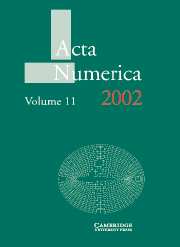Book contents
- Frontmatter
- Contents
- 1 Structured inverse eigenvalue problems
- 2 Subdivision schemes in geometric modelling
- 3 Adjoint methods for PDEs: a posteriori error analysis and postprocessing by duality
- 4 Finite elements in computational electromagnetism
- 5 Splitting methods
- 6 Topological techniques for efficient rigorous computation in dynamics
- 7 The immersed boundary method
- 8 Numerical methods for large eigenvalue problems
6 - Topological techniques for efficient rigorous computation in dynamics
Published online by Cambridge University Press: 21 May 2010
- Frontmatter
- Contents
- 1 Structured inverse eigenvalue problems
- 2 Subdivision schemes in geometric modelling
- 3 Adjoint methods for PDEs: a posteriori error analysis and postprocessing by duality
- 4 Finite elements in computational electromagnetism
- 5 Splitting methods
- 6 Topological techniques for efficient rigorous computation in dynamics
- 7 The immersed boundary method
- 8 Numerical methods for large eigenvalue problems
Summary
We describe topological methods for the efficient, rigorous computation of dynamical systems. In particular, we indicate how Conley's Fundamental Decomposition Theorem is naturally related to combinatorial approximations of dynamical systems. Furthermore, we show that computations of Morse decompositions and isolating blocks can be performed efficiently. We conclude with examples indicating how these ideas can be applied to finite- and infinite-dimensional discrete and continuous dynamical systems.
Introduction
This paper is an expository article on using topological methods for the efficient, rigorous computation of dynamical systems. Of course, since its inception the computer has been used for the purpose of simulating nonlinear models. However, in recent years there has been a rapid development in numerical methods specifically designed to study these models from a dynamical systems point of view, that is, with a particular emphasis on the structures which capture the long-term or asymptotic states of the system. At the risk of greatly simplifying these results, this work has followed two themes: indirect methods and direct methods.
The indirect methods are most closely associated with simulations, and as such are extremely important because they tend to be the cheapest computationally. The emphasis is on developing numerical schemes whose solutions exhibit the same dynamics as the original system: for example, if one is given a Hamiltonian system, then it is reasonable to want a numerical method that preserves the integrals of the original system.
- Type
- Chapter
- Information
- Acta Numerica 2002 , pp. 435 - 478Publisher: Cambridge University PressPrint publication year: 2002
- 2
- Cited by

